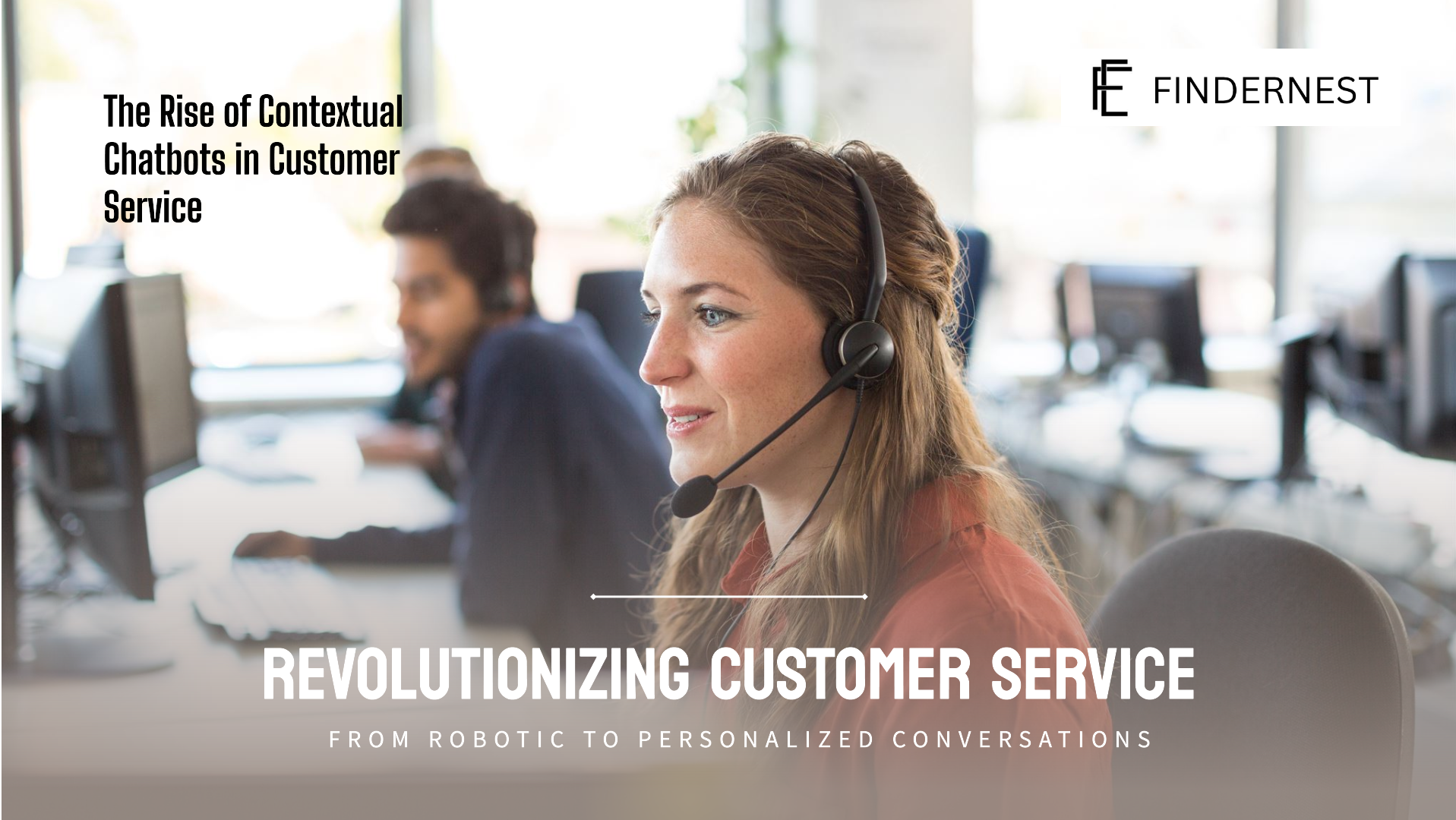Generative AI | Artificial Intelligence | AI | LLM | Retrieval Augmented Generation (RAG) | NLP | AR (Augmented Reality) | VR (Virtual Reality)
How AI and NLP Are Revolutionizing Customer Service Chatbots
Read Time 6 mins | Written by: Praveen Gundala

Modern AI and NLP technologies are transforming customer service chatbots into essential assets for businesses. By integrating with other cutting-edge technologies, like augmented reality (AR) and virtual reality (VR), chatbots may unlock new opportunities for customer interaction. As these developments progress, chatbots are expected to become even more crucial in providing outstanding customer service experiences.
Do you recall your first interaction with a chatbot? It felt almost magical—a machine imitating human dialogue! While those initial versions were intriguing, they often left users feeling more annoyed than pleased.
These basic chatbots depended heavily on prewritten scripts and keywords, resulting in clumsy and ineffective exchanges. Picture this: you pose a straightforward question, yet the bot responds with something entirely unrelated. It's no surprise many people walked away from these exasperating interactions.
Fortunately, chatbots have evolved significantly. Today's chatbots are driven by Artificial Intelligence (AI), particularly Natural Language Processing (NLP). This enables them to grasp the subtleties of human language, understand your intentions, and reply more naturally.
The era of scripted conversations is over. Contemporary chatbots can hold meaningful dialogues, accurately address your inquiries, and even offer tailored suggestions. They've become essential tools in our daily lives, enhancing our communication with businesses and organizations.
If you’re eager to understand how these once-irritating chatbots have become vital components of our lives, let’s dive in!
The World of Stilted and Rule-Based Traditional Chatbots
Let’s start with an example: You go on to a website, and suddenly a pop-up appears, asking if you need any assistance. Excited to try this new feature, you ask a question. However, the chatbot gives a completely unrelated response, thus diminishing your excitement.
But what were the different challenges that plagued these traditional chatbots? Let’s find out!
- Limited Understanding: Traditional chatbots had trouble grasping natural language, thereby resulting in misinterpretation of user queries.
- Predefined Responses: Old-school chatbots relied on rigid scripts and keywords that made conversations feel unnatural.
- Stilted Conversations: Interactions with traditional chatbots lacked the charm and essence of a human being, therefore making the interactions stilted.
- Difficulty Handling Ambiguity: Irrespective of the user query or request, they were always met with the same pre-fed response, leading to subpar experiences.
- Lack of Personalization: They failed to personalize responses according to user preferences, history, or specific needs.
- Ineffective Problem-Solving: Traditional chatbots struggled with problem-solving tasks that required creative thinking or complex reasoning beyond their scripted capabilities.
- Limited Multilingual Support: Many traditional chatbots were only trained in a single language, which means multilingual users were left out in the cold.
- High User Frustration: The chatbots failed to recognize the intent and context of user queries resulting in a high abandonment rate.
- Maintenance Challenges: Maintaining and updating predefined scripts for chatbots was labour-intensive and costly, especially as the conversation complexity increased.
- Integration Issues: Traditional chatbots faced challenges when integrating with other systems or databases, hindering their ability to provide accurate information or complete tasks.
- Limited User Engagement: Due to their limitations, traditional chatbots struggled to engage users effectively, leading to reduced user satisfaction and interaction.
As companies were adjusting to the realization that chatbots were causing more damage to the customer experience as opposed to improving it, the need for a paradigm shift became apparent.
The Transformational Impact of Natural Language Processing (NLP) on Chatbots
Natural Language Processing (NLP) stands as a groundbreaking achievement in artificial intelligence, enabling machines to grasp and generate human language. This breakthrough marked a turning point for chatbots, ushering in a new era where machines could engage in more natural and contextually relevant conversations.
With the introduction of NLP, chatbots gradually shed their robotic demeanour and started to grasp the intricacies of human communication. They could interpret context, understand synonyms, and even detect hidden meanings/ambiguous language, thus ensuring conversations take a more meaningful shape.
Here’s what they can do:
- Understanding Human Language
NLP/New-age chatbots can process and understand the complexities of human language. It discerns patterns, grammar, and syntax within human conversations, thus bridging the gap between machine and human communication.
- Contextual Understanding
With NLP at its helm, chatbots are empowered to comprehend the meaning of actual words and phrases based on the preceding and subsequent dialogue. This empowers chatbots to provide responses that align/reply in a way that makes sense with ongoing conversations, ensuring an improved interaction experience.
- Intent Recognition
NLP-powered chatbots go beyond the literal words and identify the underlying intent of a user’s query. This capability ensures that chatbots provide accurate responses even if the user’s phrasing varies, enhancing the user experience by addressing their actual needs.
However, this is not where the narrative concludes, nor where its trajectory remains stagnant.
The Next Frontier in Customer Service: LLMs and NLP Revolutionize Interactions
Despite the strides made by NLP-powered chatbots, the quest for improvement remains unending in the ever-evolving landscape of technology and user expectations. As users craved more personalized, direct, and multifunctional experiences, the emergence of Large Language Models (LLMs) became the next frontier.
LLMs elevated chatbot capabilities to unprecedented heights, enabling them to generate coherent and contextually relevant responses comparable to those of human agents. These advanced chatbots transcended language barriers, understanding user queries in various forms and drawing from extensive knowledge banks to provide accurate and detailed information. What’s more, they evolved with each interaction, continuously learning and adapting, showcasing a new era of intelligent assistants.
The integration of LLMs and NLP blurred the boundaries between human and machine interactions, allowing chatbots not only to understand explicit language but also to grasp underlying intent and sentiment. This transformative phase marked a new horizon for customer service, where empathy and relevance became the hallmarks of chatbot interactions.
From Scripted Responses to AI-Driven Conversations
The initial generation of chatbots relied heavily on scripted responses and predefined keywords, which often led to awkward and unproductive interactions. Users would frequently encounter irrelevant or off-topic replies, resulting in high levels of frustration and abandoned conversations.
However, the advent of Artificial Intelligence (AI) and Natural Language Processing (NLP) has revolutionized the chatbot landscape. Modern chatbots can now understand the nuances of human language, interpret user intent more accurately, and engage in more natural, satisfying conversations. This has transformed chatbots from mere novelties into essential tools for businesses.
Understanding Context: The Key to Human-like Interactions
A significant advancement in chatbot technology is the ability to understand context. Early chatbots often fail to grasp the subtleties of user queries, leading to misinterpretations and irrelevant responses. Today’s AI-driven chatbots can analyze the context of a conversation, allowing them to provide more accurate and relevant answers.
By understanding context, these chatbots can maintain the flow of conversation much like a human would, making interactions feel less mechanical and more engaging. This contextual awareness is crucial for delivering a seamless and effective customer service experience.
Personalization: Building Unique Customer Experiences
Personalization is another area where modern chatbots excel. Unlike their predecessors, which offered generic responses to all users, contemporary chatbots can tailor their interactions based on individual user preferences, history, and specific needs.
By leveraging data analytics and machine learning, these chatbots can provide personalized recommendations, address unique concerns, and create a more individualized customer experience. This level of personalization not only improves customer satisfaction but also fosters brand loyalty.
Multilingual Capabilities: Breaking Language Barriers
Traditional chatbots were often limited to a single language, leaving non-native speakers and multilingual users underserved. Modern chatbots, however, come equipped with multilingual capabilities, thanks to advancements in machine translation and NLP.
These chatbots can seamlessly switch between languages, making it easier for businesses to provide support to a global customer base. By breaking down language barriers, companies can ensure a more inclusive and accessible customer service experience for all users.
Introducing FRAG Framework: A Leap Forward for Customer Support
Enter FRAG, a cutting-edge framework at the intersection of technology and customer service, pushing the evolution from traditional chatbots to LLM and NLP-powered intelligent assistants. While LLMs are impressive, challenges such as inaccuracies, bias, and outdated data still linger. That’s where Fragmented Retrieval Augmented Generation (FRAG) steps in to enhance the capabilities of customer service chatbots.
Unlike traditional LLMs, FRAG introduces an additional layer—combining Federation, Retrieval, and Augmented Generation. Together, these components optimize chatbot performance, ensuring more contextually appropriate responses. The FRAG framework represents a leap forward, addressing challenges and refining chatbot interactions for a more seamless customer service experience.

From Evolution to Revolution: FRAG Unleashes New Capabilities
The FRAG framework enhances chatbot capabilities, allowing it to retrieve and generate information with unprecedented accuracy and relevance. It signifies a significant stride in the ongoing quest to continually improve customer service interactions. The world’s first FRAG-powered chatbot stands as a testament to human perseverance and innovation, promising more sophisticated interactions with LLMs, NLP, and RAG technologies at its helm. Are you prepared to explore a world where technology seamlessly merges with human needs, creating an unparalleled customer experience? Get ready for the revolution.
Future Trends: What to Expect from Next-Gen Chatbots
As AI and NLP technologies continue to evolve, we can expect next-generation chatbots to become even more sophisticated. Future advancements may include enhanced emotional intelligence, allowing chatbots to detect and respond to the emotional states of users, thereby providing more empathetic and supportive interactions.
Additionally, the integration of chatbots with other emerging technologies, such as augmented reality (AR) and virtual reality (VR), could open up new possibilities for customer engagement. As these trends unfold, chatbots will likely become even more indispensable in delivering exceptional customer service experiences.
Learn how FindErnest is making a difference in the world of business
Praveen Gundala
Praveen Gundala, Founder and Chief Executive Officer of FindErnest, provides value-added information technology and innovative digital solutions that enhance client business performance, accelerate time-to-market, increase productivity, and improve customer service. FindErnest offers end-to-end solutions tailored to clients' specific needs. Our persuasive tone emphasizes our dedication to producing outstanding outcomes and our capacity to use talent and technology to propel business success. I have a strong interest in using cutting-edge technology and creative solutions to fulfill the constantly changing needs of businesses. In order to keep up with the latest developments, I am always looking for ways to improve my knowledge and abilities. Fast-paced work environments are my favorite because they allow me to use my drive and entrepreneurial spirit to produce amazing results. My outstanding leadership and communication abilities enable me to inspire and encourage my team and create a successful culture.

